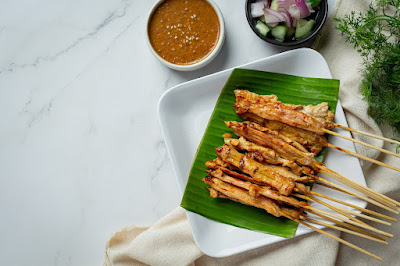Exploring the irresistible delight of Moo Satay.
In the vibrant tapestry of Thai cuisine, few dishes captivate the senses quite like Moo Satay. Originating from the southern regions of Thailand, this tantalizing delicacy, known as "Moo Satay" (with "Moo" representing pork in Thai), weaves together the aromatic flavors of succulent pork skewers and rich peanut sauce. Its exotic allure and irresistible taste have not only enamored locals for generations but have also earned it a top spot on the list of favorites for foreigners visiting Thailand.
Moo Satay epitomizes the essence of Southern Thai cuisine, where bold flavors and fragrant spices converge to create culinary magic. The dish is a testament to the region's rich culinary heritage, reflecting influences from neighboring countries and indigenous traditions. It stands as a symbol of Thailand's culinary diversity and the artistry of its people in harmonizing contrasting flavors.
At the heart of Moo Satay lies the artful combination of tender pork and a luscious peanut sauce. The pork, typically marinated in a symphony of herbs and spices such as lemongrass, turmeric, coriander, and cumin, is skewered and grilled to perfection. The result is a smoky, caramelized exterior giving way to juicy, flavorful meat, a true symphony of taste and texture.
It is the peanut sauce that elevates Moo Satay to culinary greatness. Creamy, nutty, and subtly sweet, the sauce is a perfect counterpoint to the savory pork. Made from a base of roasted peanuts, coconut milk, red curry paste, and a hint of palm sugar, the sauce adds depth and complexity to every bite. Its velvety richness coats the palate, leaving a lingering sensation of pure satisfaction.
What sets Moo Satay apart is not just its flavor, but the experience it offers. In Thailand, enjoying Moo Satay is not merely about satisfying hunger; it's a social affair, a communal ritual that brings people together. Whether enjoyed at bustling street food stalls or in the serene ambiance of a traditional Thai restaurant, Moo Satay invites diners to partake in a shared culinary journey, a celebration of food, culture, and camaraderie.
For foreigners visiting Thailand, Moo Satay often becomes a culinary highlight of their trip. Its irresistible aroma wafting through the air, the sight of sizzling skewers on the grill, and the first taste of the velvety peanut sauce, all create memories that linger long after the journey ends. Many find themselves captivated by the dish's complexity, its ability to simultaneously comfort and excite the palate, leaving an indelible mark on their culinary repertoire.
Beyond its culinary appeal, Moo Satay also serves as a gateway to understanding Thai culture and traditions. In every bite, one can taste the centuries-old culinary heritage passed down through generations. Each ingredient tells a story, reflecting the land, the people, and the vibrant tapestry of influences that shape Thai cuisine.
As with many traditional dishes, Moo Satay has evolved over time, adapting to changing tastes and preferences. Today, chefs across Thailand and beyond experiment with new ingredients and techniques, putting their own creative spin on this beloved classic. While purists may argue over the authenticity of certain variations, the essence of Moo Satay remains unchanged, a testament to the enduring appeal of Southern Thai cuisine.








